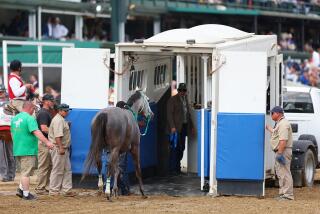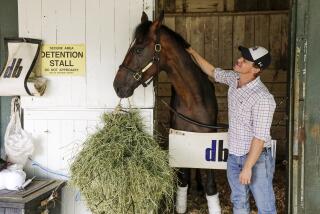Better Helmet Might Be His Legacy : Haughton’s Death Could Lead to Higher Safety Standards
- Share via
Bill Haughton is dead, and all of harness racing mourns. And for some, there are also anger and frustration.
They remember Shelly Goudreau dying of head injuries after being thrown from Regan’s Lad in the seventh race at Hollywood Park in August, 1982. They recall the similar deaths of Wayne Smullin and David Duckley on the East Coast. They point out that apparently no one learned from those tragedies.
They remember drivers in New Jersey, the top harness racing market in the world, last year balking at the suggestion of mandatory safety regulations. The issue got so heated that meetings and hearings with the state racing commission were needed to reach a settlement, and the standards were eventually lowered.
Most recently, they remember drivers at the Meadowlands staging a 15-minute work slowdown one night in January to protest additional mandatory safety measures. The issue got so heated that time around that the drivers went to court.
The drivers liked their helmets, the type, according to one study, that had about as much strength as papier-mache, and weren’t willing to switch, no matter what the tests showed.
Bill Haughton, 62, a Hall of Fame driver, didn’t switch. On July 5, at Yonkers Raceway in New York, he flipped out of his sulky and fell onto the back of his head after a collision. He died Tuesday, needlessly, according to some.
“That’s the tragedy of it, that Billy Haughton’s death could have been prevented, in my opinion,” Ron Dancer, the chairman of the safety commission for the U.S. Trotting Assn., said from Pennsylvania. “So could Shelly Goudreau’s, Wayne Smullin’s and David Duckley’s.
“I’ve been at the forefront of the situation for three or four years. Not on the safety of the helmets, but the lack of safety of the helmets. . . . It’s been very frustrating to work for so long and not even have the state associations promulgate the issues until there have been several deaths.”
Perhaps the ultimate tragedy: “I know Bill Haughton had one of those new helmets,” said Fred Kuebler, the director of racing for the Cal Expo meeting in Sacramento and a representative for drivers, owners and trainers to the Western Standardbred Assn. “He wasn’t wearing it. But I know he had one.
“No one can say whether he would be here or not, but the chances are pretty great that if he’d had a new helmet on at the time of the accident that he would be alive and walking today. There is a tremendous amount of difference in the protection involved.”
Specifically, many drivers, old-timers in particular, don’t like the newer models because, although they offer protection at the stem of the neck and 20 times as much protection, they are 30% heavier, hotter, and are said to impair side vision. It’s a trade of safety for comfort.
Dean Fisher, who has worked extensively with helmet research as senior vice president for corporate affairs at Bell helmets, said that a group of harness racing officials approached him three years ago, hoping to upgrade standards. As a starting point, he tested eight helmets, the brand names covered, with startling results.
Helmets dropped from 12 to 24 inches high with a mold of 11 pounds--the weight of the average head--registered impact readings of a bicycle helmet, previously thought to have the least amount of protection because of the aerodynamic designs, at six feet.
“So these people, if they had bicycle helmets on, would be better protected,” Kuebler said. “And that’s a sad state of affairs.”
California, like many other states, looks to the USTA for its safety regulations, and those simply say that the driver must wear a hard-shell helmet with a chin strap.
“A hard-shell helmet, you could go to a construction site and pick up a plastic helmet and have it qualify as a harness racing helmet,” Dancer said. “Helmets should be manufactured with a special compliance to safety. All sports have that, except harness racing.”
Kentucky, for one, has made it mandatory for drivers to use approved helmets. “The only state that had the guts,” Kuebler said.
Tonight in Sacramento, before racing at the State Fairgrounds, the drivers will hold their own private ceremony for Haughton. He wasn’t a California racer, except for some time spent at Hollywood Park in the 1970s, so there doesn’t figure to be any of the usual tributes that might be seen in New York or at the Meadowlands--the driverless sulky and horse heading down the stretch, the minute of silence with all the drivers in the winner’s circle.
But in California, and no doubt all over the country, Bill Haughton will be remembered.
“He gave his whole life to the sport,” Kuebler said. “If it can ever happen that a helmet will be developed that would ensure safety, that would be a definite tribute to Bill.”
More to Read
Go beyond the scoreboard
Get the latest on L.A.'s teams in the daily Sports Report newsletter.
You may occasionally receive promotional content from the Los Angeles Times.










